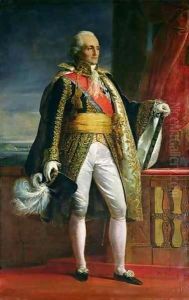Jacques Luc Barbier-Walbonne Paintings
Jacques Luc Barbier-Walbonne, born in 1769, was a distinguished French painter and illustrator whose career spanned the tumultuous periods of the French Revolution, the Napoleonic era, and the Restoration. His work, which encompasses portraits, historical scenes, and landscapes, reflects the shifting political and cultural landscapes of France during his lifetime. Barbier-Walbonne's artistic journey began under the shadow of the ancien régime, yet he adeptly navigated the changing tides of French politics and art, securing commissions and recognition across various regimes.
Initially trained in the neoclassical tradition, Barbier-Walbonne's early works were marked by a keen attention to detail, a mastery of form, and a profound engagement with the classical ideals of beauty and harmony. These qualities garnered him early success and the patronage of influential figures within the French aristocracy and, later, the revolutionary government and Napoleon's empire. Despite the upheaval of the French Revolution, Barbier-Walbonne managed to adapt and thrive, his art reflecting both the ideals of liberty and the glorification of Napoleon's rule.
Throughout his career, Barbier-Walbonne exhibited a remarkable ability to capture the essence of his subjects, a skill that made him particularly sought after as a portraitist. His portraits of key figures from the period not only serve as a testament to his technical skill but also offer a window into the personalities and power dynamics of the time. Beyond portraiture, his historical and allegorical paintings are notable for their emotional depth and narrative complexity, often imbued with themes of heroism, sacrifice, and patriotism.
After the fall of Napoleon, Barbier-Walbonne continued to work, though the Restoration period presented new challenges and shifts in artistic tastes. Nevertheless, he successfully adapted once more, contributing to the cultural life of France until well into the 19th century. His later works, while less politically charged, remained highly regarded for their craftsmanship and aesthetic qualities.
Jacques Luc Barbier-Walbonne died in 1860, leaving behind a legacy that encapsulates the turbulence, aspirations, and artistic evolution of his nation during one of its most dynamic periods. His body of work, characterized by its elegance, historical significance, and adaptability, continues to be studied and admired for its insight into the era and its artistic achievements.
